Related Research Articles

Apamea monoglypha, the dark arches, is a moth of the family Noctuidae. The species was first described by Johann Siegfried Hufnagel in 1766. It is a common, sometimes abundant, European species. It is found in most of Europe except northernmost Fennoscandia and the southern parts of the Iberian Peninsula and Greece. The species is also found in Anatolia, Turkestan, Western Asia and Central Asia, Siberia and Mongolia. In the Alps it is found up to heights of 2,500 meters. The smaller subspecies sardoa is found on Sardinia and Corsica.
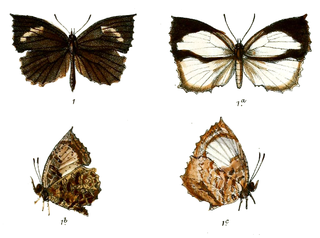
Allotinus drumila, the crenulate darkie, is a small butterfly found in India, Burma, Thailand, Laos, Vietnam, and Yunnan (China) that belongs to the lycaenids or blues family.

The silver Y is a migratory moth of the family Noctuidae which is named for the silvery Y-shaped mark on each of its forewings.
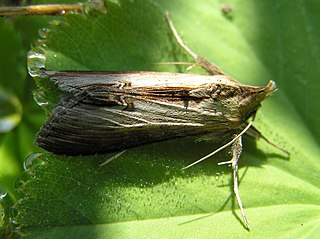
Cucullia asteris, or star-wort, is a moth of the family Noctuidae. The species was first described by Michael Denis and Ignaz Schiffermüller in 1775. It is found through the Palearctic including Japan.

The Early Grey(Xylocampa areola) is a species of moth of the family Noctuidae. It is found in Europe and Morocco.

Helotropha leucostigma, the crescent, formerly Celaena leucostigma is a moth of the family Noctuidae. It is found in the Palearctic realm.
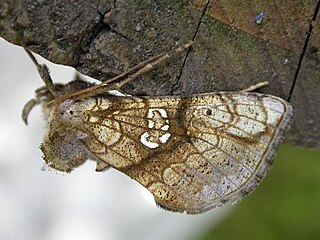
Polychrysia moneta, the golden plusia, is a moth of the family Noctuidae. It is found in the Palearctic realm.
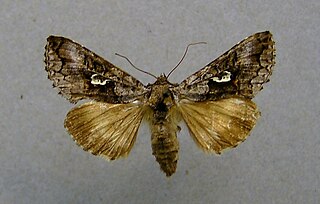
Syngrapha interrogationis, the scarce silver Y, is a moth of the family Noctuidae. It is found in northern part of the world including Alaska, Canada, Iceland, Europe, Siberia, the Pacific Northwest region of the United States, and Northeast Asia.

Catocala nymphagoga, the oak yellow underwing, is a moth of the family Erebidae. It is found in Southern Europe, from Bulgaria up to the Iberian Peninsula and sometimes further north as a migrant. It is also found in North Africa and Asia Minor.

Mesapamea secalis, the common rustic, is a moth of the family Noctuidae. The species was first described by Carl Linnaeus in his 1758 10th edition of Systema Naturae. It is found in Europe, north-west Africa, Turkey and northern Iran.
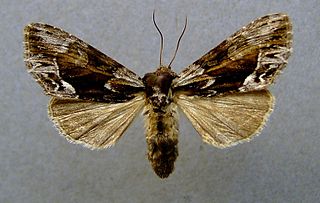
Hyppa rectilinea, the Saxon, is a moth of the family Noctuidae. It is found in Europe, but mostly in northern and central Europe. In the south, it is found in scattered populations, mainly in mountainous areas. To the east, its range stretches through northern Asia and eastern Siberia, up to the Pacific Ocean and Japan.

The double-spot brocade is a species of moth of the family Noctuidae. It is found in most of Europe, in Turkey and the west of Iran. In Anatolia it is represented by the subspecies Meganephria bimaculosa pontica.
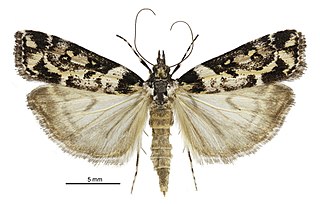
Eudonia diphtheralis is a species of moth in the family Crambidae. It is endemic to New Zealand.
Catephia pericyma is a species of moth of the family Erebidae. It is found in Egypt, Kenya, Oman, Saudi Arabia, the United Arab Emirates and Yemen.
Boryzops purissima is a species of moth of the family Erebidae. It is found in the southern United States, where it has been recorded from Florida and Texas, as well as in Veracruz in Mexico, Costa Rica and Jamaica.
Epipsestis castaneata is a moth in the family Drepanidae. It was described by Warren in 1915. It is found in Sikkim in India, Hunan in China and in Nepal and Vietnam.
Habrona concinna is a moth in the family Drepanidae. It is found in Papua and Papua New Guinea, where it has been recorded from mountainous areas.
Nothoploca nigripunctata is a moth in the family Drepanidae. It is found in India, Vietnam, Korea, China and the Russian Far East.
Takapsestis curvicosta is a moth in the family Drepanidae. It is found in Assam, India.
Takapsestis semiobsoleta is a moth in the family Drepanidae. It is found in Indonesia.
References
- ↑ Beccaloni, G.; Scoble, M.; Kitching, I.; Simonsen, T.; Robinson, G.; Pitkin, B.; Hine, A.; Lyal, C., eds. (2003). "Epipsestis orbicularis". The Global Lepidoptera Names Index . Natural History Museum . Retrieved May 28, 2018.
- ↑ Some new oriental Cymatophoridae in the Tring museum